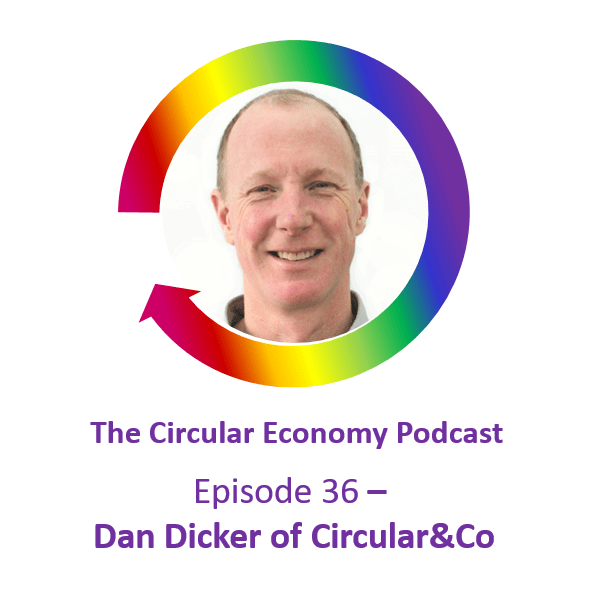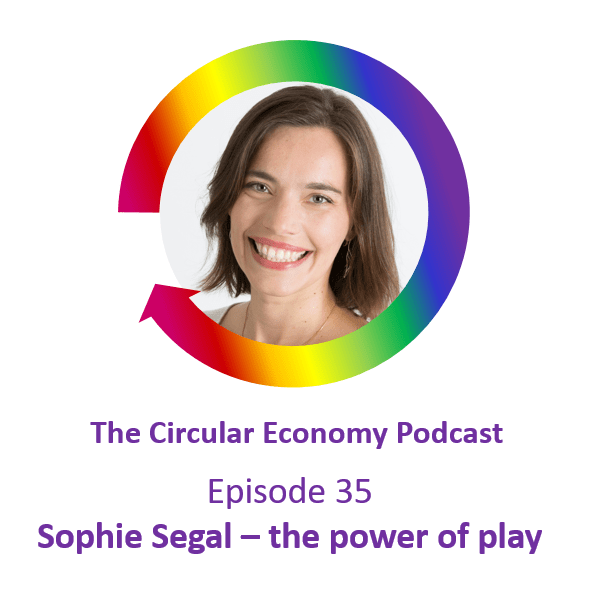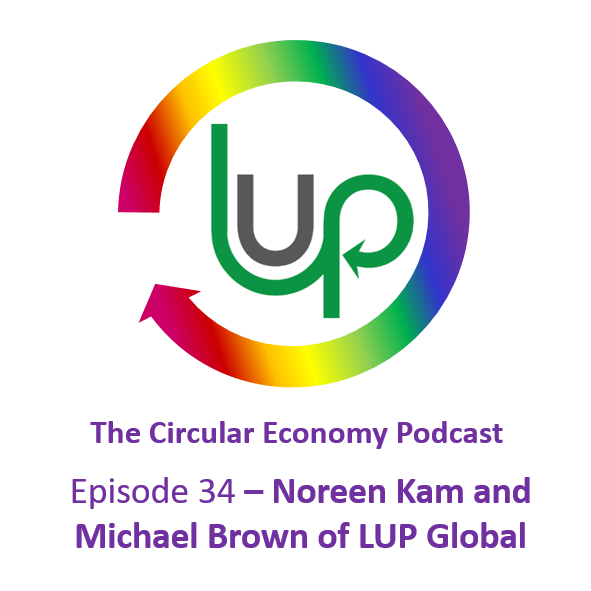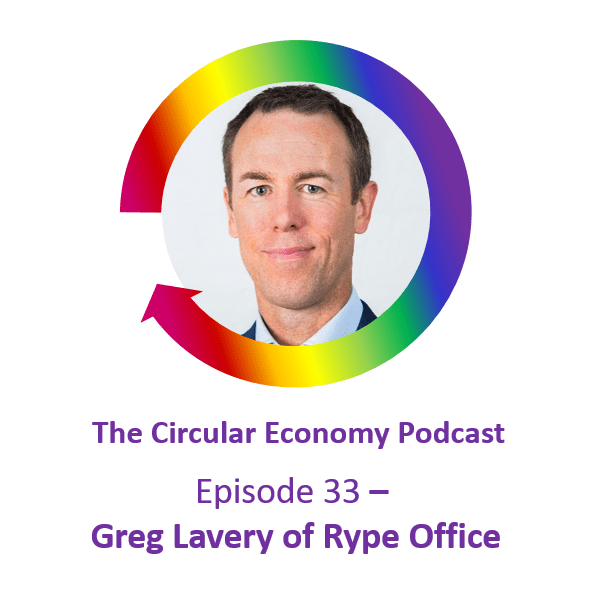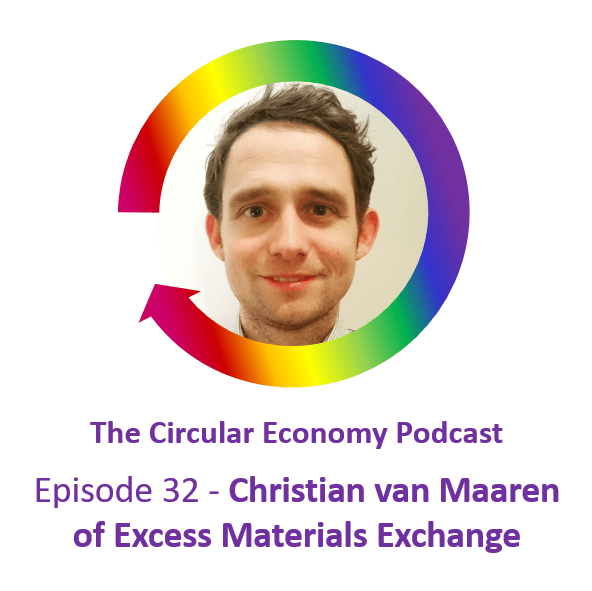Podcast: Play in new window | Download
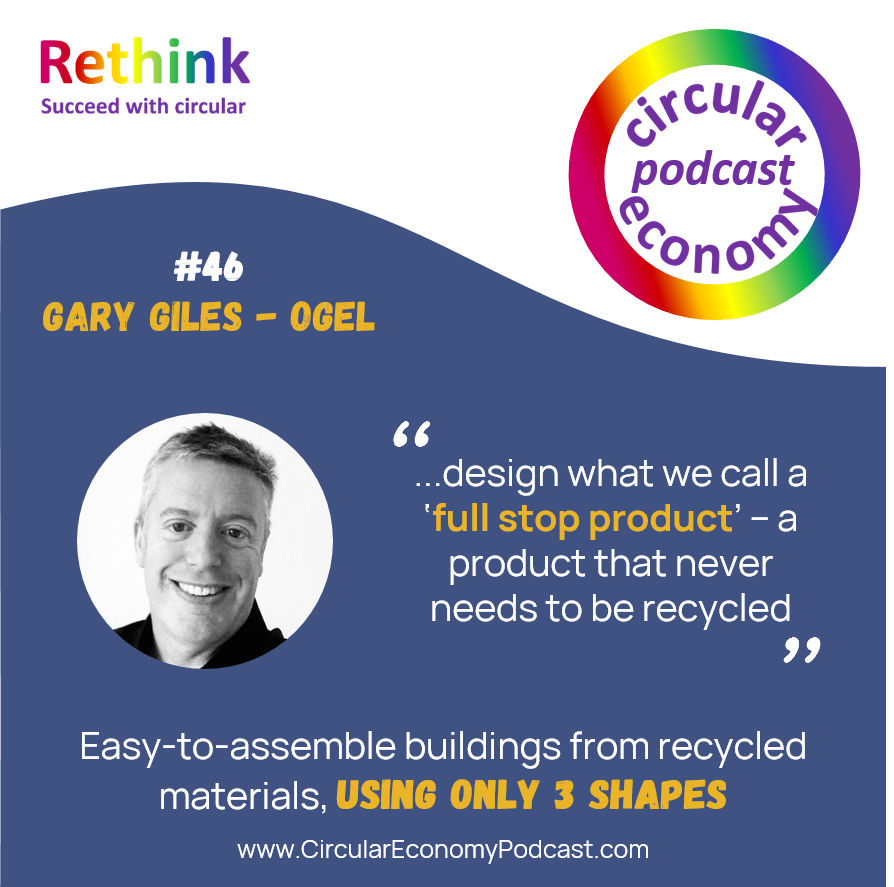
Today, we’re talking to yet another entrepreneur inspired by the circular economy. Gary Giles set up his company, OGEL, to use a material that is quite difficult to recycle, and very bulky, so transporting it to be recycled is expensive. We’ll hear how Gary was inspired by the modular design of Lego, and how he’s developed a way of constructing durable, well-insulated buildings that use only 3 shapes, are easy to assemble and need very few tools.
Podcast host Catherine Weetman is a circular economy business advisor, workshop facilitator, speaker and writer. Her award-winning book: A Circular Economy Handbook: How to Build a More Resilient, Competitive and Sustainable Business includes lots of practical examples and tips on getting started. Catherine founded Rethink Global in 2013, to help businesses use circular, sustainable approaches to build a better business (and a better world).
Stay in touch for free insights and updates…
Read on for a summary of the podcast and links to the people, organisations and other resources we mention.
You can subscribe to the podcast series on iTunes, Google Podcasts, PlayerFM, Spotify, TuneIn, or search for “circular economy” in your favourite podcast app. Stay in touch to get free insights and updates, direct to your inbox…
Links we mention in the episode:
- The new Circle Lab database from Circle Economy https://knowledge-hub.circle-lab.com/
- Save our Soil online conference 24-26 February http://save-our-soil.org/
- Gary Giles on LinkedIn https://www.linkedin.com/in/gary-giles-56751014/
- OGEL https://ogel.world/
- The 2-minute video showing how the OGEL building system works is on the OGEL website, or here https://youtu.be/SDua6D4QBPQ
- Project SPECIFIC and the ‘building as a power station’ concept: https://www.specific.eu.com/about-us/
- https://epsrc.ukri.org/newsevents/casestudies/buildings-as-power-stations/
- https://www-2018.swansea.ac.uk/press-office/news-archive/2019/turninghomesintopowerstationscouldcuthouseholdfuelbillsby600ormore-report.php
- Richard Parker of E3 Design Ltd https://www.e3design.co.uk/
About person
 Gary is Founder of OGEL, which is a rapid construction system that turns waste plastic into walls, floors and roofs.
Gary is Founder of OGEL, which is a rapid construction system that turns waste plastic into walls, floors and roofs.
It is easy to use, lightning quick to assemble and dismantle, multi-purpose, modular and fully reusable, and can be recycled to make new OGEL… which is why they call it a Full Stop Product.
To better understand it watch this 2minute video https://youtu.be/SDua6D4QBPQ
Interview Transcript
Provided by AI – add ~3mins 30 secs for the finished episode
Catherine Weetman 00:04
In today’s episode, I’m talking to Gary Giles, founder of OGEL. Whilst at work one day Gary Giles and his old boss were trying to think of additional uses for a new piece of bagging equipment that he just purchased. Their idea was to make reusable sandbags for flood defences. However, they quickly realised that whilst the reusable idea was great, they still had to figure out how to join the sandbags together. If they wanted to build a watertight wall, they’d arrived at the age old construction problem. How do you build a wall without using something to glue or hold identical parts together? Gary, welcome to the circular economy podcast.
Gary Giles 00:43
Hello, Catherine.
Catherine Weetman 00:45
And it’s good to see you. And yes. I think you might be the almost the nearest guest so far to where I am in North Yorkshire because you’re up in Newcastle. Is that right?
Gary Giles 00:58
At the minute I’m on the banks of the river Tyne. And it’s a lovely place to be, you know, sort of it’s a little bit chilly here. But that’s part of the course sometimes, up here
Catherine Weetman 01:06
Good stuff. So please carry on with that story. How have you How have you solved that age old construction problem,
Gary Giles 01:14
basically solve the problem that we’ve solved. And how we solved it is by going back to look at how we learn to build as children really, and if you think about when you’re a child, you get wooden blocks, and then you get into Lego blocks. And then for those who sort of grew up in going to the trade, you get in you get in bricks, and that the basic this, this is the same shit. So the problem you’ve got is joining, if you think about Lego block terms, you can join Lego blocks up and down, quite straightforward. But what you can’t do is join two Lego blocks side to side without using either a block bullet or a block above it to like sort of sort of tie pieces together. So what we did was, we figured out this method of manufacture called extrusion, which is business of just making long ships which are then cut to whatever length you want. And what we do is we take an L ship, and then we tessellate it, which means 10 round, upside down, and we take an L shape, and turn it upside down on its head with another piece to make a block ship. And then what we do is we join the L shapes, sort of back to front, and sort of build the wall, sideways by linking shorter and longer pieces together a bit like a brick wall on its side, if that sort of makes sense. And that means that there’s optic see one week Long’s and we can make a 10 metre long wall, but from the same piece of Sydney about overlapping the pieces. Wow. So one of these things works best.
Catherine Weetman 02:48
So what you’ve come up with as a as a kind of modular piece that can be used in to link everything else together. And you just repeat and repeat and repeat. But it’s linking it’s it’s kind of locking, locking the pieces together, sideways, as well as vertically. Up and down. Yeah, yeah.
Gary Giles 03:10
Yeah. Because if it was, because what happens is, if you the problem with any sort of building sideways is you’ve got to join the side picture the side piece, whereas if you overlap the pieces, then technically you don’t have it, you only ever have a half Jones, you know, have a full joint, right, the front and the back of the wall. So what you tend to do is overlap, so that so that the joint at the front overlaps with the middle of the piece at the back, which means it joins at its strongest point, almost, you know,
Catherine Weetman 03:42
and you’ve got a nice little mix for goes on. Sorry.
Gary Giles 03:48
Yep. Yep. I mean, once again, sort of, it’s one of these things where it’s hard to sort of sort of do on a podcast What if anybody would stop can’t have a look at it, how it works, you can see an hour video of it working in a two minute video on our website, which is OGEL that’s o g e l dot world.
Catherine Weetman 04:09
And that’s what I was just gonna say when I was when I was interrupting. I was just gonna say you’ve got a nice little video on the website that shows a building being constructed and how just how easily everything goes together. You know, without any glues or fixings and goes round corners and, you know, just makes makes or leave spaces for doors and windows to be fitted and all that sort of stuff. So it looks it looks brilliant. And where did the end of use materials come from? And you know, what, what materials are they made of?
Gary Giles 04:41
Okay, so we’ll be starting based. We could use PVC, both. From a strength perspective. styrene is actually the best material to build out of, it’s better from a strength perspective, you can build it thicker would be lighter, it’s it’s not as expensive. It’s also from a worse perspective, one of well, depending on depending on the source, one of one of the, the worst materials to sort of come back and turn around again because of staring tends to come in and have this sort of expanded format of packaging. Yeah, so we use so we use so we use things like, it could be fish boxes, it could be old signage. Back in the day, it was CD cases. We will also use the linings, the inside linings of fridge freezers, computer casings, printer casings, which all tend to be sort of high impact polystyrene. So there’s plenty of the plenty of, of sources if you like, you know, yeah, and because it’s a wall, it was a wall. So as with most walls, you can do it in black, we can do it in white and do it in… depending on the source of material. And it works pretty well. So if we use like, like all fish boxes, or in our packaging, that’s comes in white, well, the colour tends to sort of steer steer whites, you know, sort of wait for the outside darker colours for the, for the, let’s say, white for the inside, you’ll see that colours for the inside, you know?
Catherine Weetman 06:28
Yeah, that sounds good. So that’s brilliant, that you that you’re taking a whole load of quite problematic waste materials, because I remember from my DHL days, the problems of trying to get polystyrene, and particularly the packaging recycled. And it wasn’t just the, the need for specialist recycling facilities. It was the logistics costs of getting it there because of course, it was all really bulky. And so it you know, it’s quite an expensive problem.
Gary Giles 06:59
So it is, and it’s one of these, go on, sorry
Catherine Weetman 07:02
I was just gonna say how many thinking about the blocks, how many different shapes or sizes of blocks do you need, say for, doing a building with a floor and a roof and so on.
Gary Giles 07:12
We just use one shape for everything one our shear, fantastic. That’s just how we call it sort of what we do how we do have our cover piece that – we have two other pieces really, which is there with what’s called what’s called an X tile, which is a piece that goes through the block at the bottom and the top to join it to join it to the to the other courses. And we have a piece that goes on the inside, like a clip that goes on the inside, which joins the left to the right, and make sure that the left and the right can separate, right. Or we can use screws, it’s sort of we can do it either way. Really, you know, the idea was to try and come up with a building which you don’t need any tools for that theoretically, you could do off your hands, or at most with a screwdriver.
Catherine Weetman 08:02
Wow, that’s, that’s. Yeah, I really like that principle. That’s because Fairphone is one of the examples that I always use, which, you know, you can take apart and replace the modules on that with just a single screwdriver. And yet, you know, for lots of products, particularly tech products, you know, it’s kind of special tools and proprietary kits and things like that, which all all seems designed to just stop anybody getting inside it even to replace the battery. So that’s brilliant that it’s, you know, it’s all from a single shape of blocking and how do you fit doors and windows? How does that work?
Gary Giles 08:40
What we have is we have an extrusion that’s like a C shape that goes around in building terms, you call it a window open your door opens that that’s called reveal. So what happens is, is that we effectively go around the reveal with a bit a bit like a pitcher feeling reverse almost go on the outside, and then we simply drill, or screw, the window, the doors stripped to that reveal.
Catherine Weetman 09:09
Right. So so there’s no there’s no kind of, you know, difficulty in making something that’s, you know, fully functional. As you said humanitarian shelter or garden shed or saw one of the examples on the video, I guess, sort of office space in warehouses and things like that when you might want something that again, you can move around easily or you can, you know, start small and then realise you need it that you need a bigger space now because of Coronavirus and physical distancing rules so you could just take it down and add a few more blocks in and make it a different size and shape.
Gary Giles 09:50
Exactly that I mean. I mean, I’m guessing you probably guessed but obviously the name is OGEL which is actually Lego backwards. Obviously Lego is the inspiration
Catherine Weetman 10:01
Brilliant now I haven’t guessed that that’s really good. Yeah,
Gary Giles 10:04
yeah. So that’s, that’s why they have a look at the logo, the logo has the arrow pointing sort of left to right, rather than right to left. The idea is, I want to play a three to one game versus label itself in such a way that where does the name come from? And I’m able to do a three to one year of sort of first question. first clue is, what’s it made out of asked me that was plastic. That plastic. Okay, yeah. second clue. What was it do to build a product? Okay. Third clue was also which was which way on the name does the arrow point?
Gary Giles 10:40
Lego. Yeah. Because, yeah, I mean, because Lego was the sort of that was the inspiration, as the inspiration is how it sort of stuff. It’s nothing like Lego looks nothing like Lego. It’s all really. But that you’re sort of building something out of plastic? Is it anybody in the world have ever seen it? Sort of, you know, we don’t make a plastic building, what would you use? That’s a Lego, you know, so but the idea is, is that in the years to come the goal, you know, sort of so. So, if you want to make a plastic building, make it from a little bit of a joke, you know?
Catherine Weetman 11:21
Yeah, that’s brilliant. Well, I hope, hope you’ve trademarked enough so that Lego can sort of pinch your design and use it for a more flexible building brick. Yeah. Method carrying forward. I know that. Yeah. Lego do do have quite a few circular economy ambitions, but haven’t looked closely at what those are.
Gary Giles 11:41
Yeah, I mean, sort of, I mean, I think things I mean, I mean Lego, funnily enough, it uses a very similar material called abs, which is, which is, which is also stone in this product. What the I think it’s a beautiful styrene I can remember the the base of the essence styrene. But the nature of liberal is that it does, it’s difficult for it to sort of break down and be recycled, because it’s a thermostatic plastic, rather than a thermal downy plastic. You know, so it’s hard to read, read, when would that mean with my own knowledge of plastic? Yeah. So that’s why I suspect that there might be some issues in that respect. But that being said, it would be lovely to sort of think that in years to come we could turn some old Lego into Ogel, you know that that’ll be that’d be a beautiful, but a bit a bit a bit of circular economy, wouldn’t it? You know,
Catherine Weetman 12:33
yeah, absolutely. Yeah. Yeah. And turning a toy into into say, humanitarian shelters or something like that would be a good story, wouldn’t it? So where whereabouts whereabouts? Have you set up production, Gary?
Gary Giles 12:44
production initially, I should explain is that as that sort of production is really making something of this nature, and in the excuse me, and the extruded sizes that we’re making, it’s quite large. There’s only sort of two companies in the whole of the UK do it, right? Because there’s lots, there’s lots of custom made in China, which is great for trunk channels. Fantastic. What do you imagine, it’s a bit crazy, sort of given the amount of waste we have in the UK, it’d be a bit daft to take that waste put on a boat, send it from China, make our profiles out of it and then send it back to the UK. So we found somewhere in the, after much, a lot of work, we found somebody in the UK would do it for us, who were down and based in Worcester, and they’ve been fantastic and very productive and helping helping us get the product really ready to go to market, you know, and deal with only the the real world problems of actually making this stuff, you know, which is which are quite quite difficult. So that just, you know, sort of it was a, it was it was quite a task to overcome really?
Catherine Weetman 13:52
Hmm. Well, that sounds good, though. Making sure it’s made and, you know,
Gary Giles 13:58
At source, at source.
Catherine Weetman 13:59
Yeah. And I guess once you’ve sorted out the processes for making it, then you have the potential to licence those processes so that things can be made more locally if you want it to go down that. Exactly. Exactly.
Gary Giles 14:15
Exactly. That I mean, if you think about with any product really sort of, you’ve got a raw material, you’ve got a process, and then you’ve got a finished product in very basic terms, you know, well of yours, if you think about the raw material that we need, which is which is waste. styrene is all around the world. It’s it’s everywhere. So so so the raw material is not really a problem. The process is relatively straightforward. And then what we’ll make at the end of it is something which was because it’s a wall as a reusable wall. It’s got a very, very, very, very, very long lifestyle. I mean, so I mean, we act as sort of as part of the marketing campaign, which is a little bit of a joke, but it’s also at the same time, so It comes with it’s of the products going to come with a 999 year anti-rot guarantee. Because it’s not going to rot, you know
Catherine Weetman 15:09
Yeah. Wow, that’s good. So can the blocks be recycled at the end of use? You know, even even if it does stand for 99 years or you know, 199 or whatever? What can you do with your locks at the end of use? At the end of it?
Gary Giles 15:26
Take them, take them back, shred them up again, melt them again and make another one out of it.
Catherine Weetman 15:31
Brilliant. So perfect circular economy, then that’s really good. And what about some of the other challenges of buildings in different locations? So, you know, for a UK installation, can you insulate the blocks?
Gary Giles 15:46
Well, yes, we can insulate the blocks. But then again, we don’t really have to, because we have a test on it. And whilst we haven’t got the final numbers back, because it’s styling bits, and if you think about a lot of installation, any housemade from styling, because we have effectively a thick wall with a styrene, a trapped air space, which is which is a… trapped air is definitely a good insulator.
Catherine Weetman 16:14
Yeah,
Gary Giles Catherine Weetman 16:14
another book while staring. It’s certainly as warm up to twice as warm as a normal double skin brick wall house.
Catherine Weetman 16:23
Wow. That’s amazing.
Gary Giles 16:26
Yeah, so you don’t actually need insulation in the walls
Catherine Weetman 16:31
Wow, that’s really good. Um, yeah,
Gary Giles 16:33
Yeah. And because we make the roof up the same process, how we make the roof is that we make the walls we turn the wall on its side to build the roof. Hmm. That puts all the principles exactly the same. So really, because of in most houses, most, heat the last run the windows and doors, or is lost to the roof. And because the roof effectively meant them styrene now, it It’s going to retain all the heat.
Catherine Weetman 17:04
Yeah. And I guess I guess the same applies to the, to the floors, because we live in a pretty old house. And one of the problems we had when we were renovating it was how far we had to dig down to put hempcrete in, you know, to get some insulation in because we It was just an earth floor. And but, you know, even if you put concrete in or something like that it’s not. It’s not an insulator, is it? But I guess from what you’re saying? Then the flow would be insulating to which would be really good in in cold climate.
Gary Giles 17:38
Correct. Exactly. So very hot climates, you know, sort of, I mean, we are, I’ve been working on a lot of different ideas, obviously. So our main focus is to get the building, right first, the practice of doing with a company in the northeast, very early stage who have invented a, a solar panel wall, the idea is that what we’ll do is either using photovoltaic panels, which you can probably get them on which which will work fine. But the idea is that, that we would roll is on the roof of wall on the walls, and then put batteries in the void in the wall. So the idea is, is that you just stole the only power in the wall? You know, and the batteries are actually quite heavy anyhow. So you can actually make fully self contained buildings, you know?
Catherine Weetman 18:29
Yeah, excellent.
Gary Giles 18:31
From a power perspective, you know, but at the same time, you can’t because there’s, there’s there’s plenty of voids in the world to fill. So you can make a very, very so and on top of them about initially is doing some work in India, whereby because of something in India so the big problem with Indian Sub Saharan Africa is not so much growing the crops although that is an issue. It’s storring the crop so that they don’t rot. You know, so if you’ve got if you’ve got, I mean, in the UK, we want the buildings to be warm in, in Sub Saharan Africa and in India you don’t, you want the buildings to be cool to be cool. So if you can effectively put a fridge unit in the building, and then power the building from the solar panels on the roof and start the panel’s store the power in the walls, then, you know, so you should be able to give you a much longer shelf life on the crops that are grown.
Catherine Weetman 19:34
Hmm, yeah, I’m sure there’s lots of different directions that you could take it in using solar power and so on. And that reminds me of a project I heard about in circular Peterborough last year with Swansea University working on buildings as a power station, using lots of new solar panel technology that they were trying to design the the panel’s themselves to be, you know, circular Economy principles so that they could be taken apart afterwards if new, new technology came along, that was that was better. But it was, you know, it wasn’t traditional solar panels. It was the fabric of the building, which just looked like a kind of, you know, a normal model. Maybe as, you know, visually, it might look like it was clad in metal or something like that. But it was also love panels. Yeah. So yeah, really innovative. I’ll look that up for you afterwards and share details
Gary Giles 20:29
That would be fantastic if you could do.
Catherine Weetman 20:31
So excellent. And so thinking about all the stuff that you’ve been learning about sustainability in the circular economy, and so on, who would you recommend as a guest for the programme to inspire people about going circular or to talk about the problems of the linear economy and how to change things so that they’re more circular?
Gary Giles 20:52
Yeah, I think a good guy to speak to the guy who, who did a lot of the design work for bill in in getting off the ground and a guy called Richard Parker, who has a company called E3 Design in Newcastle, who do a lot of work in designing products. And he’s got some interesting stories to tell us to stop how some of the some larger companies that they do work for now, attempting to design, you know, recyclability and reusability into some of their products, you know, and give it in some cases, give it a long give it a great longevity as well, depending on the product. You know,
Catherine Weetman 21:35
that sounds good.
Gary Giles 21:36
He he be a great guy.
Catherine Weetman 21:38
Excellent. Well, I’ll hook up with you and get get his contact details afterwards. Thank you. And looking back on your entrepreneurial career and the lessons that you’ve learned trying to get a startup off the ground and you know, find somebody to produce the, the blocks for you and all that all that kind of stuff. What top tips would you share with anybody wanting to either start a circular business or take their business in a more circular direction?
Gary Giles 22:08
I would also say from my from my take on it, I was also says it’s crystal.. This is, look at a treating it as, initially, how you would deal with any product? Is there a need? So is it still? So is there a need is there a customer a base is that it’s because the market should be wide enough? And then the final question should always be is okay, I know this, I know that there’s a need. And there’s a market now. So before I even sort of put pen to paper, or try and design this product, how can I then recycle? What about what I’m thinking about making so it becomes sort of the last step, but it’s all part of the same process, you know, so so get it right in the in the design stage. Because if you get in the design stage, and you think about all the possibilities and options that can go wrong, and how you can recycle it and reuse it and give it greater lifespan, then then you design out hopefully the worst problem as I certainly minimise the waste problem. And the final thing I would stop says is, is do what we try to do and design what we call a full stop product, ie a product that never needs to be recycled. Because its lifespan, you build in the real you’re building reusability you’re building longevity into the products, ie It never has to be recycled. So try and build a full stop product.
Catherine Weetman 23:46
Fantastic. Any new phrase for circular economy enthusiasts all over the world full stop products. Excellent. Thank you very, that’s really good advice. I think that could help a lot of startups particularly and product designers, you know, looking at how they design the next next range of products to start with that as a as a key priority. And to ask that question at every stage, and I guess, you know, how can I recycle it? or How can I make it even easier to recycle? And that starts with you know, can I disassemble it to begin with and you know, as well as the materials that it’s made out of? So thank you. Exactly, yeah, that sounds really sensible. And Gary, how can people get in touch and find out more and have a look at that nice little short video on your website? Where would they find it?
Gary Giles 24:34
Okay, so the best way to look at it is to go to www.ogel.world that’s O G E L – Lego backwards – dot world. So that’s why www.ogel dot world.
Catherine Weetman 24:47
Okay, fantastic. And we’ll put that link in the show notes as well in case people don’t Well, I’m sure the the Lego bits easy isn’t it is perhaps what? What comes after that, but yeah, thank you, man. Maybe Thinking about Lego and changing the world by going going circular. So, Lego backwards and world. Excellent. Thank you very much. Well, Gary, that’s been really interesting. And I look forward to hearing more about how it’s going. And I know my husband was, was looking at the video and had designs on it for his, you know, possible office shed. So, so maybe we’ll talk afterwards about the potential to do that. Great. Sure.
Gary Giles 25:27
We can get some stuff. That’s brilliant. Okay. Thank you very much.
Catherine Weetman 25:31
Thanks, Gary. Good luck with it.
Gary Giles 25:33
Thank you.
Want to find out more about the circular economy?
If you’d like to learn more about the circular economy and how it could help your business, why not listen to Episode 1, or read our guide: What is the Circular Economy?
To go deeper, you could buy Catherine’s book, A Circular Economy Handbook: How to Build a More Resilient, Competitive and Sustainable Business. This comprehensive guide uses a bottom-up, practical approach. It includes lots of real examples from around the world, to help you really ‘get’ the circular economy. Even better, you’ll be inspired with ideas to make your own business more competitive, resilient and sustainable.
Please let us know what you think of the podcast – and we’d love it if you could leave us a review on iTunes, or wherever you find your podcasts. Or send us an email…
Podcast music
Thanks to Belinda O’Hooley and Heidi Tidow, otherwise known as the brilliant, inventive and generous folk duo, O’Hooley & Tidow for allowing me to use the instrumentals from the live version of Summat’s Brewin’ as music for the podcast. You can find the whole track (inspired by the Copper Family song “Oh Good Ale”) on their album, also called Summat’s Brewin’. Or, follow them on Twitter.
